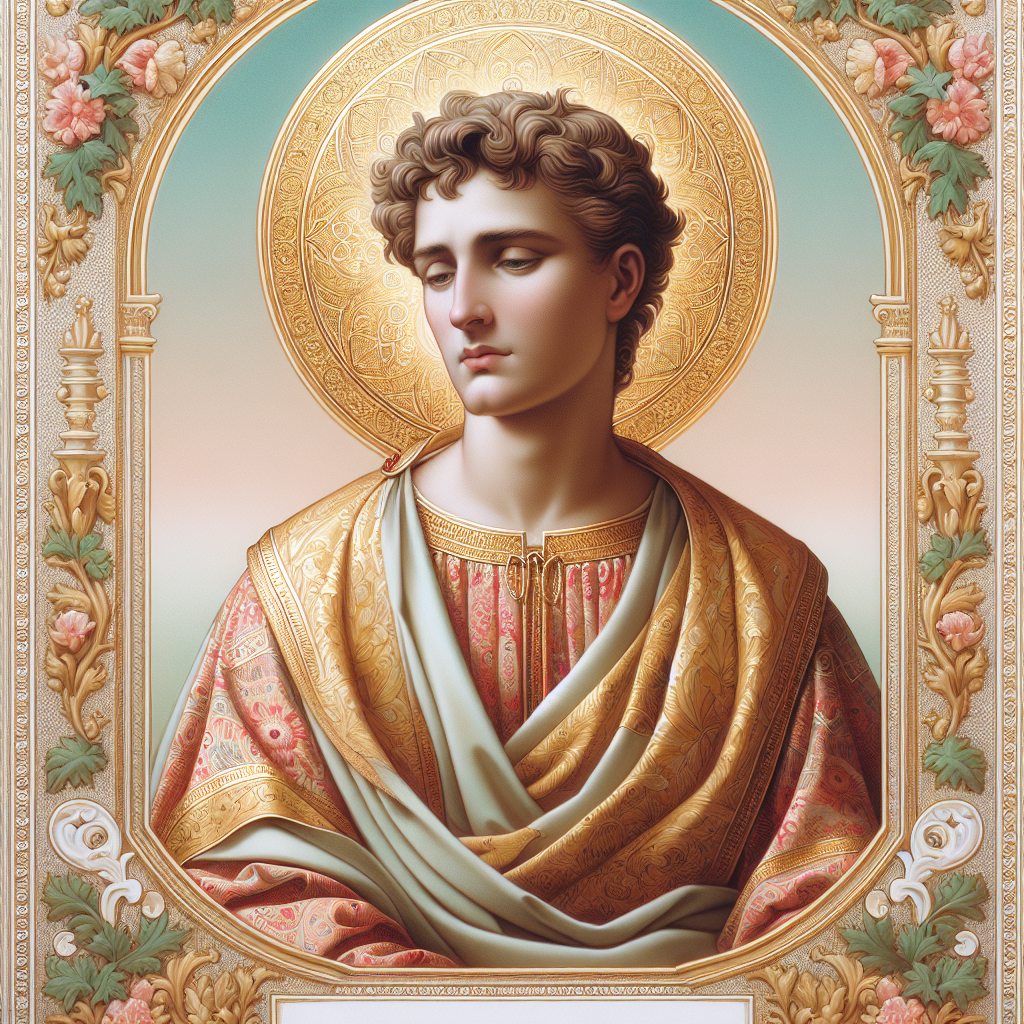Saint prayer cards, also known as holy cards, have been cherished by the faithful for centuries. These small, intricately designed cards typically feature an image of a saint on one side and a prayer or invocation on the other. They serve as a tangible connection to the divine, offering *comfort*, *spiritual guidance*, and a sense of *closeness* to the holy figures depicted on them.
Originating in Europe during the 15th century, saint prayer cards were initially produced as woodcuts and later evolved with the advent of printing technology. They became widely popular by the 19th century, often being distributed by churches and religious organizations as a means to inspire devotion and provide solace in times of need.
Today, these cards are used for various purposes, including personal prayer, as keepsakes in memorial services, and as tokens of faith shared among friends and family. Whether placed in a wallet, tucked into a Bible, or displayed in the home, saint prayer cards serve as daily reminders of the virtues and intercessory power of the saints they honor.
At DisciplePress, we understand the profound impact that saint prayer cards can have on individuals and families. That’s why we offer a wide range of beautifully designed funeral and memorial prints to help you honor your loved ones in a meaningful way. Order funeral & memorial prints today and keep the memory of your loved ones alive with our exquisite offerings.
Historical Significance of Saint Prayer Cards

The historical significance of saint prayer cards is deeply intertwined with the spread of Christianity and the development of religious art and literature. The origins of these cards can be traced back to the early days of printmaking in the 15th century when the invention of the printing press by Johannes Gutenberg revolutionized the production of religious materials. Prior to this, religious imagery and texts were manually crafted, making them rare and expensive.
With the advent of the printing press, the production of religious cards, including saint prayer cards, became more accessible and widespread. These early cards, often created as woodcuts or engravings, featured simple yet powerful images of saints along with prayers or scriptures. They were used by missionaries and clergy to educate the faithful, promote devotion, and encourage moral living.
During the Counter-Reformation in the 16th century, the Catholic Church recognized the potential of saint prayer cards as tools for reinforcing Catholic doctrine and piety. The Church began to produce and distribute these cards more extensively, often depicting saints who were venerated for their exemplary lives and miraculous deeds. These cards became an important means of fostering personal devotion and reinforcing the Church’s teachings.
By the 19th century, advancements in lithography and color printing allowed for more elaborate and visually appealing cards. This period saw a proliferation of saint prayer cards, which were often given as gifts, used in religious education, and kept as personal mementos. The tradition of exchanging and collecting these cards became a popular devotional practice, reflecting the deep spiritual significance they held for many believers.
Through the centuries, saint prayer cards have remained a beloved and enduring expression of faith, providing comfort, inspiration, and a tangible connection to the divine for countless individuals around the world.
Different Types of Saint Prayer Cards

Saint prayer cards come in a wide variety of types, each designed to meet different devotional needs and preferences. These variations not only reflect the diversity of saints venerated within the Christian tradition but also the personal and cultural contexts in which these cards are used.
Classic Saint Prayer Cards: These are perhaps the most common type, featuring traditional images of saints along with prayers, usually printed on high-quality card stock. They often include a short biography or a description of the saint’s virtues and miracles, making them ideal for personal devotion and education.
Patron Saint Cards: Many people seek the intercession of saints who are patrons of specific causes, professions, or life situations. Patron saint cards typically include a prayer asking for the saint’s guidance and protection in relation to their specific patronage. For example, Saint Jude is often invoked for hopeless cases, while Saint Anthony is the patron saint of lost items.
Novena Cards: These cards are designed for use in novenas, which are a series of prayers recited over nine days. Novena cards usually feature detailed instructions and specific prayers to be said each day, along with an image of the relevant saint. They are a powerful tool for sustained and focused prayer.
Commemorative Cards: Often created to mark special religious events, such as canonizations or feast days, commemorative saint prayer cards are highly collectible. They may include unique artwork, special prayers, and details about the event being commemorated.
Customized Saint Prayer Cards: For those who wish to create a more personalized devotional item, customized saint prayer cards offer the option to include specific prayers, images, and even personal messages. These cards are often used for special occasions like baptisms, confirmations, and funerals, adding a unique and meaningful touch to the event.
Each type of saint prayer card serves as a cherished reminder of faith, offering a focused way to seek spiritual support and connect with the divine. Whether for personal use, educational purposes, or as a thoughtful gift, these cards continue to play an important role in the spiritual lives of many.
Benefits of Using Saint Prayer Cards

Saint prayer cards offer numerous benefits that extend beyond their physical form, making them invaluable tools for spiritual growth and comfort. Here are some of the key advantages:
Spiritual Connection: Saint prayer cards serve as tangible reminders of the spiritual realm, helping individuals feel a closer connection to the saints and, by extension, to God. This connection can provide a sense of peace and reassurance, especially during difficult times.
Guided Prayer: For those who may find it challenging to articulate their prayers, saint prayer cards offer structured and time-honored prayers that can guide one’s devotional practice. These prayers, often rooted in centuries of tradition, can be a source of spiritual nourishment and inspiration.
Educational Value: Many saint prayer cards include biographical information about the saint, their virtues, and the miracles attributed to them. This educational aspect can deepen one’s understanding of the faith and inspire individuals to emulate the virtues of the saints in their own lives.
Portable and Convenient: One of the most practical benefits of saint prayer cards is their portability. They are small enough to fit in a wallet, pocket, or purse, making it easy to carry them wherever you go. This convenience allows for spontaneous moments of prayer and reflection throughout the day.
Emotional Comfort: Many people find solace in the act of holding and praying with a saint prayer card. The physical presence of the card can be a source of emotional comfort, especially when dealing with grief, anxiety, or uncertainty. Knowing that others have found strength through the same prayers can also be reassuring.
Gift of Faith: Saint prayer cards make thoughtful and meaningful gifts for various occasions such as baptisms, confirmations, weddings, and funerals. Giving a saint prayer card is a way to share a piece of one’s faith and offer spiritual support to others.
Incorporating saint prayer cards into your daily life can enrich your spiritual journey, offering guidance, comfort, and a deeper connection to the divine. Whether used for personal devotion or given as a gift, these cards hold a special place in the hearts of many believers.
How to Choose the Right Saint Prayer Card

Selecting the right saint prayer card can be a deeply personal and meaningful process. Here are some tips to help you make the best choice:
Identify Your Needs: The first step is to consider the specific needs or intentions you have. Are you seeking comfort during a difficult time, looking for guidance in your spiritual journey, or wanting to honor a particular saint? Identifying your needs will help narrow down your choices.
Research the Saints: Each saint has unique attributes, virtues, and areas of patronage. For instance, Saint Jude is known as the patron saint of hopeless causes, while Saint Anthony is the patron of lost items. Doing some research on the saints can help you find one whose life and virtues resonate with your current circumstances or spiritual goals.
Consider the Artwork: Saint prayer cards often feature beautiful and inspiring artwork. The imagery can play a significant role in your connection to the card. Look for artwork that speaks to you personally and evokes a sense of peace, inspiration, or devotion.
Check the Prayers: Review the prayers included on the card. Some cards feature traditional prayers, while others may include modern interpretations or personalized prayers. Choose a card with prayers that you find meaningful and that align with your personal prayer style.
Quality and Durability: Since saint prayer cards are often carried around or used frequently, it’s important to consider the quality and durability of the card. Look for cards made from sturdy materials that can withstand daily use. Laminated cards or those made from durable paper are often good choices.
Personal Connection: Ultimately, the best saint prayer card is one that you feel a personal connection with. Trust your intuition and select a card that feels right for you. This personal connection can enhance your prayer experience and make the card a cherished part of your spiritual practice.
Choosing the right saint prayer card is a thoughtful process that can deeply enrich your devotional life. By considering your needs, the attributes of the saints, and the elements of the card itself, you can find a prayer card that provides spiritual support and inspiration.
Personalizing Saint Prayer Cards for Memorials

Personalizing saint prayer cards for memorials adds a unique and heartfelt touch that can provide comfort to grieving family and friends. Here are some ways to personalize these cards to honor the memory of a loved one:
Include a Photo: Adding a photo of the deceased can make the prayer card more personal and meaningful. Choose a picture that captures their spirit and essence, creating a lasting memory for those who receive the card.
Add Custom Text: Personalize the card with custom text such as the name of the deceased, dates of birth and passing, and a brief message or quote. This information can remind recipients of the person’s life and legacy, offering solace and reflection.
Select a Favorite Saint: If the deceased had a particular devotion to a saint, including that saint on the prayer card can be a beautiful tribute. It can also provide a sense of continuity and connection for family members who share the same devotion.
Choose a Meaningful Prayer: Select a prayer that was significant to the deceased or one that offers comfort and hope to those mourning. Personalized prayers or those that reflect the individual’s faith journey can add a special touch to the card.
Consider the Design: The design of the card can also be tailored to reflect the personality and interests of the deceased. Choose colors, fonts, and imagery that resonate with their life and character, creating a card that is as unique as the person it commemorates.
Incorporate Symbols and Icons: Religious symbols, icons, or even personal symbols that were meaningful to the deceased can be included on the card. These elements can provide additional layers of comfort and remembrance.
Personalizing saint prayer cards for memorials is a thoughtful way to honor a loved one’s memory and provide comfort to those who are grieving. Each personalized element adds to the card’s significance, turning it into a cherished keepsake for family and friends.
Order funeral & memorial prints today at DisciplePress, LLC, and create a lasting tribute to your loved one.
 Free Shipping Over $50
Free Shipping Over $50  888-432-8363
888-432-8363


 Obituary/Programs
Obituary/Programs No-Fold Memorial Programs
No-Fold Memorial Programs 4 Page Funeral Programs
4 Page Funeral Programs 8 Page Memorial Programs
8 Page Memorial Programs 12 Page Funeral Programs
12 Page Funeral Programs 16 Page Funeral Programs
16 Page Funeral Programs 20 Page Funeral Programs
20 Page Funeral Programs Tri-Fold Funeral Programs
Tri-Fold Funeral Programs Complete Memorial Packages
Complete Memorial Packages
 Cards & Bookmarks
Cards & Bookmarks Saint Prayer Cards
Saint Prayer Cards Folded Memorial Cards
Folded Memorial Cards Folded Holy Cards
Folded Holy Cards Memorial Bookmarks
Memorial Bookmarks Thank You Cards
Thank You Cards Share-A-Memory Cards
Share-A-Memory Cards Memorial Magnets
Memorial Magnets
 Memorial Posters
Memorial Posters Guest Books
Guest Books Slide Shows
Slide Shows Memorial Fans
Memorial Fans Death Announcements
Death Announcements Take Away Keepsakes
Take Away Keepsakes
 Church Products
Church Products









